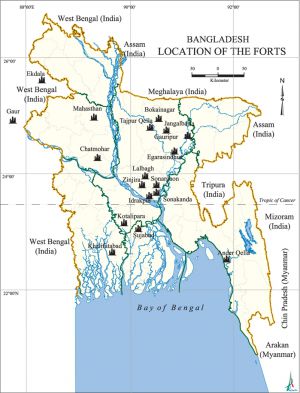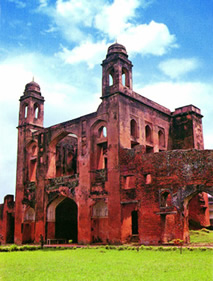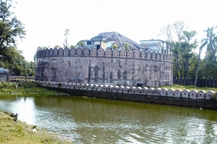Fort
Fort a structure used for the purpose of defence against attacks and usually having troops stationed. Generally, there are two types of fortifications: permanent and field ones. The former is usually of great strength, erected in times of peace as a defence against attacks. It is meant to defend cities, border outposts, sea or river coasts, and trading centres. Permanent fortifications include walls, castles, forts and fortresses. Field fortifications are constructed hastily in time of wars. They include trenches, foxholes, weapon emplacements, minefields, breastwork made of logs, mud walls etc. and obstacles such as barbed wire.

Kautilya (in arthashastra) classified forts (durga in Sanskrit) into six types: Dhanva durga (desert-fort), the Mahidurga (mud-fort), the Jaladurga (water-fort), the Giridurga (hill-fort), the Vana-durga (forest-fort) and Nara durga (fort protected by men). The methods adopted for the defence of the cities of India can be broadly divided into two categories: (i) natural fortifications (Akrtrima-durga) and artificial fortifications (Krtima-durga).
In Bangla, durga is generally applied to all kinds of fortifications. In addition, there are many other synonymous terms such as duar, kot, kella, burj, khitta, damdama, chauki etc. The word durga is related to all types of forts within the topographical speciality of the terrain of Bengal. In riverine Bengal, fortifications were erected at the junction or on the bank of rivers. Canals, large tanks (dighis), moats (nalas) and ditches were provided to strengthen the defence system in keeping with the physiography and topography of the land. Bengal's monsoons and its cyclic rotation of seasons in association with the vagaries of nature also contributed to its defence. During the rainy season the expanse of water become wider and the almost regular seasonal flooding made the defence system of Bengal impregnable. In consideration of this fact, it is not difficult to imagine that the rivers of Bengal acting as arteries, largely responsible for shaping up the defence system of Bengal. The fact was undoubtedly used as an important element of defence of the great ancient forts of mahasthan and kotalipara.
There are some literary references to the existence of numerous mud-forts in Bengal. The peculiar geographical and climatic condition accounted for the emergence of this kind of structure. For exactly the same reason, other kinds of forts were not or could not be constructed. The strength of Bengal's forts depended predominantly on natural defences and not only on their fortified walls. In consequence, Bengal contained mainly two types of forts; mud-forts (mahidurga) and water forts (jaladurga).

The entire area of ancient Bengal is dotted with numerous forts. Due to scarcity of stone, forts in Bengal were usually mud-built. Almost all pre-Muslim forts of Bengal were mud-forts. However, with the passage of time these have turned into mounds. So far as ancient and early medieval Bengal is concerned it is very difficult to reconstruct the history and architectural pattern of the forts due to extreme scarcity of structural evidence.
The excavations at mahasthangarh reveal that pundranagara, the earliest fortified city of Bangladesh, was provided with a natural defence by the river Karatoya and other measures of ancient fortifications, such as mud-walls. In Mahasthangarh, one finds all the distinctive features of an ancient city fort in Bengal. The rectangular plan of the city is common and is widely observed over the entire terrain of Bengal.
The devices developed through the ages in Bengal have exerted immense influence on the medieval forts and fortifications introduced by the Muslims. The forts and fortifications of medieval Bengal were seen as exemplary and many later forts have grown out of the synthesis of the two main sources, the pre-Muslim tradition of the land, and the art of building forts brought by the Muslims. The fort architecture was developed and elaborated in two distinct phases, the Sultanate and the Mughal ones, over a span of more than five hundred years.

Though only a few of them survive, the extant buildings of the Sultanate period and also the contemporary imperial fort structures in other parts of India may give us some idea about the nature of the Sultanate forts in Bengal. The forts of this period were of the following categories: (i) Damdama Forts (or siege-forts); (ii) Capital Forts; and (iii) Border Outposts. The forts built during the Mughal period in Bengal may be arranged under three heads: (i) Border Outposts; (ii) River Forts and (iii) Palace Forts. The fortifications of medieval cities like sonargaon and khalifatabad cannot be traced accurately owing to the encroachment of the rivers. In the capital city of pandua some remains of fortification walls have survived. ekdala was a siege type of fort or damdama fort and is typical of the forts of Sultanate Bengal.
The city of gaur with its central citadel is the lone surviving structure of fort architecture and the last specimen of its kind. However, even here a good number of buildings are known to have disappeared while some survive in dilapidated condition in this once famous capital.
Most medieval cities were defended by means of surrounding rampart walls. But in some cases, as a measure of additional protection, strongly fortified citadels were added in one corner of the town. The outer fortification and central citadel of Gaur, even in their ruins, are not difficult to identify.

A comprehensive study of the origin, growth and development of medieval fort architecture in Bengal makes it clear that it did not reach its climax in the Mughal period. The ideal type of fort building was built during the time of the independent sultans. The achievement in the field is best reflected in the full-fledged example of the citadel of Gaur.
It is evident that for consolidation of their power in Bengal the Mughals had to build several forts as border outposts. The forts at Chatmohor (Pabna), Sujabad (Barisal), bokainagar, Gauripur, egarasindhur, jangalbari, Qila Tajpur (Mymensingh) and andar qila (Chittagong) are a few surviving examples.

The three consistent components of medieval forts in Bengal were walls, towers, and gates. In general, the architectural features of Mughal forts follow previous patterns. It is evident that in an unfamiliar geo-physical environment, the Mughals took necessary defensive measures and evolved river forts. The forts of hajiganj, sonakanda and Idrakpur Fort are good representatives of the type of river forts built by the Mughals to defend their capital city of Dhaka from portuguese and magh raids. The river forts mark a happy fusion of the defensive requirements of the Mughals and the physiographic peculiarities of Bengal.
The Mughals also built a few palace forts, but none of them attained the stature of the standard palace forts seen in north India. The palace forts at jinjira (Keraniganj) and lalbagh (Dhaka) are poor examples of the type which the Mughals developed in their imperial capitals.
In the initial period of the coming of the English in Bengal, the need for a fortified place was felt, and hence the construction of fort william. Though initially a fortified place for the English, it gradually became the centre of their administration. But with the passage of time the fort became obsolete. [Ayesha Begum]
See also lalbagh fort; hajiganj fort; sonakanda.
